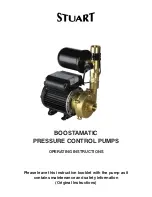
3DJH
VAPOR LINE SERVICE VALVE (VALVE OPEN)
FIGURE 9
SCHRADER VALVE
SERVICE PORT
SERVICE PORT
CAP
STEM CAP
SNAP RING
INSERT HEX
WRENCH HERE
VAPOR LINE SERVICE VALVE (VALVE CLOSED)
INLET
(FROM INDOOR COIL)
OUTLET (TO
COMPRESSOR)
KNIFE EDGE
SEAL
SCHRADER VALVE OPEN
TO LINE SET WHEN
VALVE IS CLOSED
(FRONT SEATED)
SERVICE PORT
SERVICE PORT
CAP
(VALVE FRONT
SEATED)
SNAP RING
STEM
CAP
OUTLET
(TO COMPRESSOR)
KNIFE EDGE SEAL
INLET
(FROM INDOOR COIL)
INSERT HEX
WRENCH HERE
Do not attempt to backseat this valve. Attempts to
backseat this valve will cause snap ring to explode
from valve body under pressure of refrigerant.
Personal injury and unit damage will result.
DANGER
3-- Replace stem cap tighten firmly. Tighten finger
tight, then tighten an additional 1/6 turn.
To Close Vapor Line Service Valve:
1-- Remove stem cap with an adjustable wrench.
2-- Using service wrench and 5/16 hex head exten-
sion, turn stem clockwise to seat the valve. Tight-
en firmly.
3-- Replace stem cap. Tighten finger tight, then tighten
an additional 1/6 turn.
/($. 7(67,1*
After the line set has been connected to the indoor
and outdoor units, the line set connections and in-
door unit must be checked for leaks.
WARNING
Never use oxygen to pressurize refrigeration or air
conditioning system. Oxygen will explode on con-
tact with oil and could cause personal injury.
When using high pressure gas such as nitrogen or
CO
2
for this purpose, be sure to use a regulator
that can control the pressure down to 1 or 2 psig.
Using an Electronic Leak Detector or Halide
1-- Connect a cylinder of nitrogen with a pressure reg-
ulating valve to the center port of the manifold
gauge set.
2-- Connect the high pressure hose of the manifold
gauge set to the service port of the vapor valve.
(Normally, the high pressure hose is connected to
the liquid line port, however, connecting it to the
vapor port better protects the manifold gauge set
from high pressure damage.)
3-- With both manifold valves closed, open the valve
on the R22 bottle (vapor only).
4-- Open the high pressure side of the manifold to al-
low R22 into the line set and indoor unit. Weigh in
a trace amount of R22. (A trace amount is a maxi-
mum of 2 ounces or 3 pounds pressure.) Close
the valve on the R22 bottle and the valve on the
high pressure side of the manifold gauge set. Dis-
connect R22 bottle.
5-- Adjust nitrogen pressure to 150 psig. Open the
valve on the high side of the manifold gauge set
which will pressurize line set and indoor unit.
6-- After a short period of time, open a refrigerant
port to make sure the refrigerant added is ade-
quate to be detected. (Amounts of refrigerant will
vary with line lengths.) Check all joints for leaks.
Purge nitrogen and R22 mixture. Correct any
leaks and recheck.






























